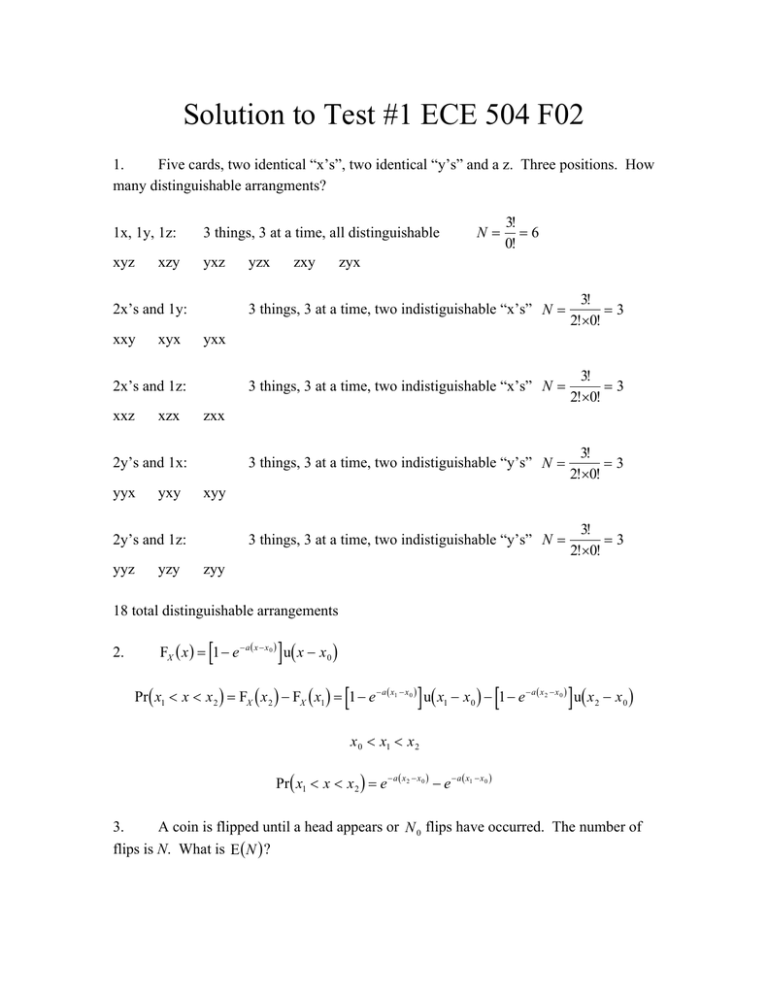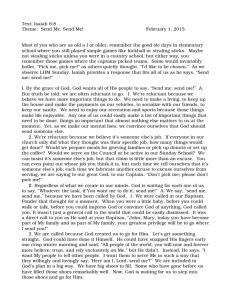Solution to Test #1 ECE 504 F02
advertisement

Solution to Test #1 ECE 504 F02
1.
Five cards, two identical “x’s”, two identical “y’s” and a z. Three positions. How
many distinguishable arrangments?
1x, 1y, 1z:
3 things, 3 at a time, all distinguishable
xyz
yxz
xzy
2x’s and 1y:
xxy
xyx
xzx
yxy
yzy
3 things, 3 at a time, two indistiguishable “x’s” N =
3!
=3
2!×0!
3 things, 3 at a time, two indistiguishable “x’s” N =
3!
=3
2!×0!
3 things, 3 at a time, two indistiguishable “y’s” N =
3!
=3
2!×0!
3 things, 3 at a time, two indistiguishable “y’s” N =
3!
=3
2!×0!
xyy
2y’s and 1z:
yyz
zyx
zxx
2y’s and 1x:
yyx
zxy
3!
=6
0!
yxx
2x’s and 1z:
xxz
yzx
N=
zyy
18 total distinguishable arrangements
2.
[
]
FX ( x ) = 1 − e − a ( x − x 0 ) u( x − x 0 )
[
]
[
]
Pr ( x1 < x < x 2 ) = FX ( x 2 ) − FX ( x1 ) = 1 − e − a ( x1 − x 0 ) u( x1 − x 0 ) − 1 − e − a ( x 2 − x 0 ) u( x 2 − x 0 )
x 0 < x1 < x 2
Pr ( x1 < x < x 2 ) = e − a ( x 2 − x 0 ) − e − a ( x1 − x 0 )
3.
A coin is flipped until a head appears or N 0 flips have occurred. The number of
flips is N. What is E ( N ) ?
Pr ( N = 1) =
1
1
1
, Pr ( N = 2) = , L Pr ( N = N 0 − 1) = N 0 −1
2
4
2
[
]
Pr ( N = N 0 ) = 1 − Pr ( N = 1) + Pr ( N = 2) + L + Pr ( N = N 0 − 1) =
N0
E ( N ) = ∑ n Pr ( N = n ) =
n =1
N0
+
2 N 0 −1
N 0 −1
1
2
N 0 −1
n
∑2
n =1
n
4.
A man can go to the office by two routes. Route #1: N1 minutes to a bridge, N 2
more minutes to the office. Route #2: N 3 minutes to the office. N 3 > N1 + N 2 .
Pr (bridge out ) = p0 . When bridge is out he returns home and then takes the longer route.
What is his expected travel time, E (τ ) ?
E (τ ) = ( N1 + N 2 )(1 − p0 ) + (2 N1 + N 3 ) p0
5.
(a)
(b)
A probability space is {A, B, C, D, E , F } . All outcomes are equally likely.
Number of events is 2 N where N is the number of outcomes, in this case, 6.
Number of events is 64.
Event, X, is {A, C, F } and event, Y, is {B, C, E } . X ∪ Y = {A, B, C, E , F } .
Pr ( X ∪ Y ) = Pr ( A) + Pr ( B) + Pr (C ) + Pr ( E ) + Pr ( F ) =
6.
5
6
The pdf of X is constant between x1 and x 2 , x 2 > x1 , and has an impulse of
strength, 0.4, at x 3 .
E( X ) =
∞
x2
∫ x p ( x )dx = K ∫ xdx + 0.4 x
X
−∞
K=
3
x1
0.6
x 2 − x1
E( X ) =
x
x + x1
0.6 2
0.6 1 2
xdx + 0.4 x 3 =
x 2 − x12 ) + 0.4 x 3 = 0.6 2
+ 0.4 x 3
(
∫
2
x 2 − x1 x1
x 2 − x1 2
7.
Two men and two women. Probability of a man being left-handed is 0.15.
Probability of a woman being left-handed is 0.1.
Pr (2 LH people) = Pr (0 LHM) Pr (2 LHW ) + Pr (1 LHM) Pr (1 LHW ) + Pr (2 LHM) Pr (0 LHW )
Pr (0 LHM) Pr (2 LHW ) = (0.85) (0.1) = 0.007225
2
2
2
1
1 2
1
1
Pr (1 LHM) Pr (1 LHW ) = (0.15) (0.85) (0.1) (0.9)
1
1
Pr (1 LHM) Pr (1 LHW ) = 4[(0.15)(0.85)(0.1)(0.9)] = 0.0459
Pr (2 LHM) Pr (0 LHW ) = (0.15) (0.9) = 0.018225
2
2
Pr (2 LH people) = 0.007225 + 0.0459 + 0.018225 = 0.07135







